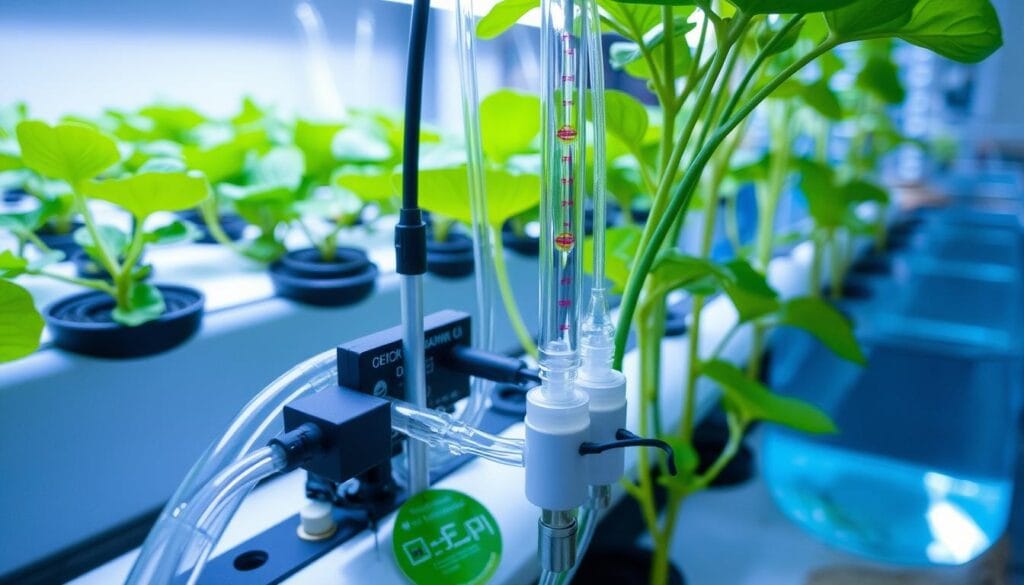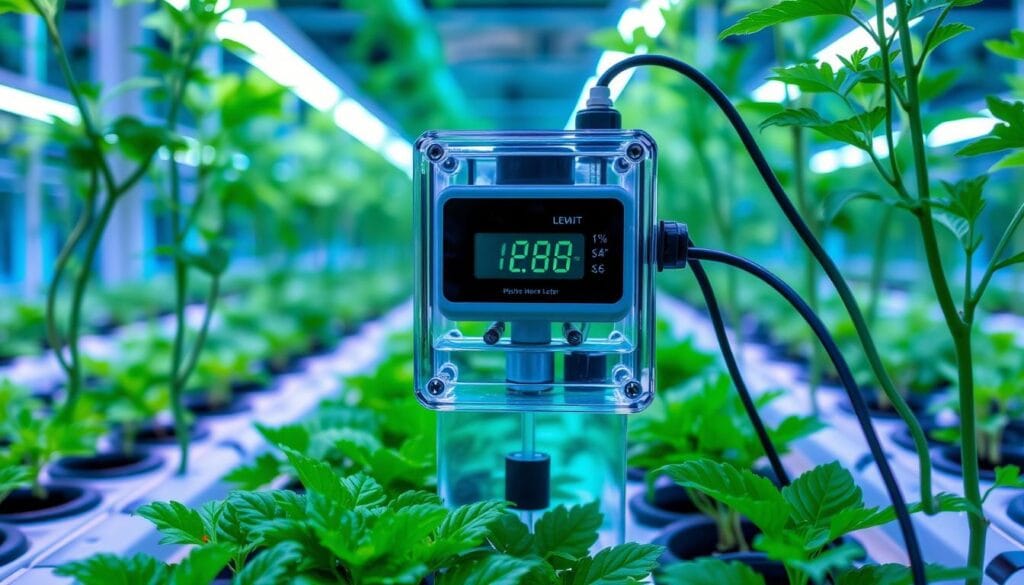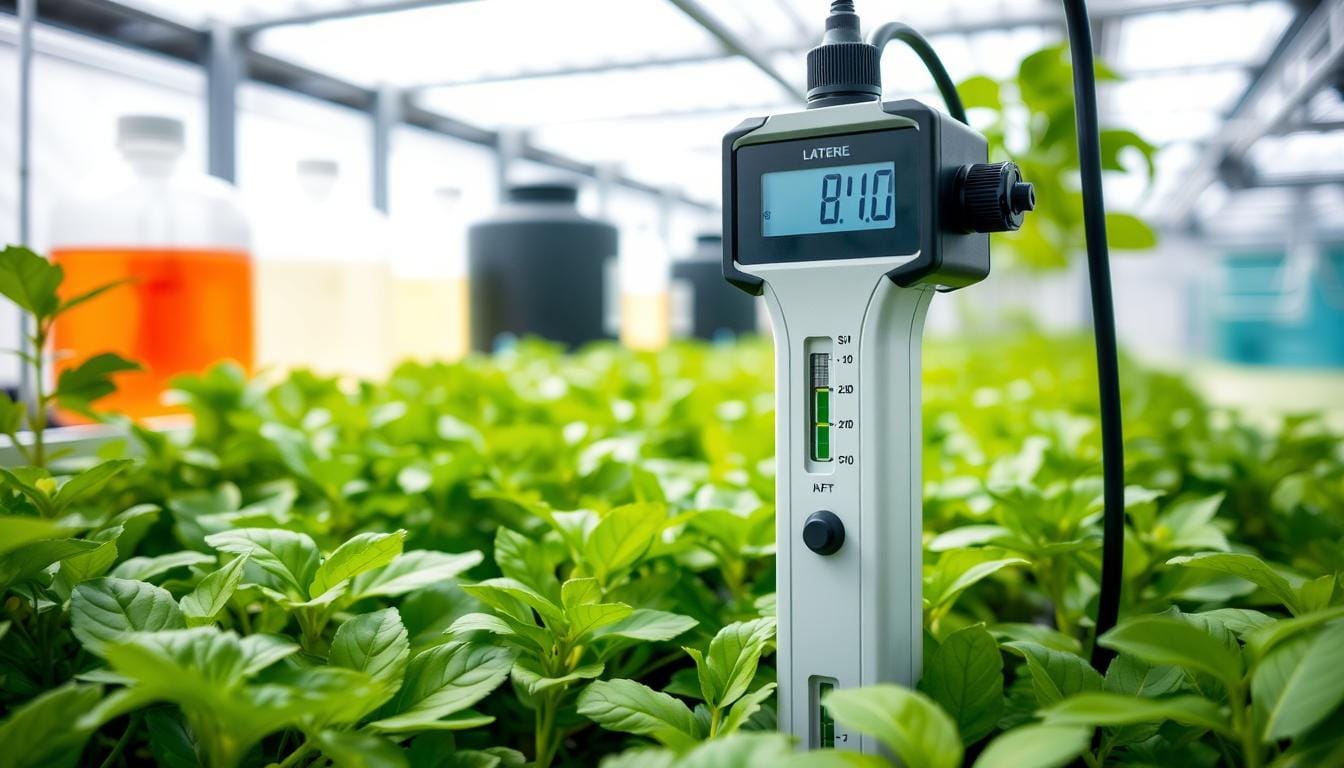Starting your hydroponic journey means keeping water levels just right. A water level meter is key for your plants to get the moisture they need. With new tech, digital gauges and sensors are now a must-have for growers. They let you watch and adjust water levels closely, changing the game for your indoor garden.
Choosing a top-notch water level meter can help your plants thrive. A digital gauge keeps your system running smoothly. A sensor gives you updates in real time, helping you make better choices for your garden.
Key Takeaways
- Investing in a water level meter for hydroponics can improve plant health and productivity
- Digital water level gauges offer precise control over water levels
- Hydroponic water level sensors provide real-time data for informed decision-making
- Optimal water levels are key for a healthy indoor garden
- A high-quality water level meter is a valuable addition to your hydroponic system
Understanding Water Level Meters in Hydroponic Systems
Exploring hydroponics means learning about water level monitoring. A hydroponic reservoir level monitor is key for keeping water levels right. It stops overwatering and underwatering, helping plants grow well. An automated controller keeps the water level perfect by always checking it.
A hydroponic water level monitoring system gives you updates on water levels. It also tracks pH and nutrient levels, all important for plants. With this system, your plants get the right water and nutrients, leading to better growth.
The Role of Water Level Monitoring
Monitoring water levels is vital in hydroponics. It stops diseases and root rot by keeping water levels just right. A hydroponic reservoir level monitor gives you updates, helping you adjust as needed.
Impact on Plant Health
Water level monitoring greatly affects plant health. It helps plants grow well, lowers disease risk, and boosts yields. An automated controller keeps water levels perfect, helping your plants thrive.
Types of Monitoring Systems
There are many monitoring systems for hydroponics, including:
- Automated water level controllers
- Hydroponic water level monitoring systems
- Manual monitoring systems
Each system has its benefits and drawbacks. Your choice depends on your needs and preferences.
Why Your Hydroponic Setup Needs a Quality Water Level Meter
As a hydroponic grower, you know how vital it is to keep the water level just right. A good water level sensor is key to healthy plants and high yields. It gives you accurate readings, helping you save water, prevent root rot, and grow strong plants.
Here are some top benefits of using a quality water level meter in your hydroponic setup:
- Improved plant growth and yields
- Reduced water waste and conservation of this valuable resource
- Increased accuracy and reliability in water level readings
- Peace of mind for hydroponic growers, knowing that their system is functioning optimally
A top-notch water level sensor can spot problems early. If the water is too low, roots get stressed and plants grow poorly. Too much water can cause roots to rot.
By choosing a quality hydroponic water level indicator, you keep your system efficient. Your plants get the right water to thrive. With the right tools, you can boost yields, improve plant health, and cut down on waste.
| Benefits of Quality Water Level Meter | Description |
|---|---|
| Improved Plant Growth | Accurate water level readings promote healthy root development and increase yields. |
| Water Conservation | Reduced water waste and optimized water usage |
| Increased Accuracy | Reliable water level readings for informed decision-making |
Top Features of Modern Water Level Meters for Hydroponics
For hydroponic systems, a good water level meter is key for plant growth. A smart meter lets you monitor and control water levels in real time. Look for a digital gauge to see the water level.
Modern water level meters for hydroponics have great features. Here are some:
- Digital display technologies for easy reading and monitoring
- Wireless connectivity options for remote monitoring and control
- Alert systems and notifications to warn you of any changes or issues
- Data logging capabilities to track and analyze water level trends over time
These features help hydroponic growers a lot. They make monitoring and control easier, and more convenient. And help with data analysis. A top-notch smart water level meter can boost your hydroponic system’s performance and plant health.
A digital water level gauge lets you keep an eye on your hydroponic system’s water level. This helps avoid overwatering or underwatering, which harms plants. With a modern meter, you can create the best-growing conditions and reach your hydroponic system’s full capacity.
The Latest Innovations in Hydroponic Water Level Monitoring
Exploring hydroponics shows how key a good water level monitoring system is. It keeps water levels just right, so plants get the moisture they need. An automated controller helps, making adjustments as it goes.
New tech in hydroponic monitoring includes better sensors and data tools. These help track water, temperature, and more, affecting plant growth. Using these, you can make your hydroponic system better, saving water and helping plants grow strong.
- Monitor water levels from anywhere
- Get alerts when water levels are off
- Make water level changes automatically
These new tools can boost your hydroponic gardening. You’ll see better efficiency, more growth, and higher yields. With the right system and controller, your plants will thrive.
Smart Integration and Automation Capabilities
Exploring hydroponics shows how vital a smart water level meter is. It helps make your growing process more efficient and productive. You can control and monitor your hydroponic system from afar, improving plant growth and cutting down on waste.
A hydroponic water level sensor is key to this system. It gives you real-time water level data. This lets you make automatic changes to keep your plants in the best conditions. It saves time and cuts down on mistakes, ensuring your plants get the right water and nutrients.
Mobile App Control
Mobile app control lets you check and tweak your hydroponic system from anywhere. You get alerts for low water levels or other issues. This quick response helps keep your plants growing well and reduces downtime.
Smart Home Integration
Smart home integration boosts your hydroponic system. It connects devices for easy control from one place. This makes things more convenient and gives you a better view of your system, helping you find ways to improve.
Automated Adjustment Systems
Sensor-driven automated systems regulate water levels by analyzing real-time data. This ensures your plants get the right moisture and nutrients. It boosts growth and saves water, making your hydroponic system more efficient and green.
Installation Guide for Hydroponic Water Level Sensors
Setting up a hydroponic system requires a good hydroponic water level sensor. It helps keep the water level right for your plants. A water level sensor for hydroponic setups stops your plants from getting too wet or dry.
To install a hydroponic water level sensor, follow these steps:
- Choose a suitable location for the sensor, ensuring it’s submerged in the water reservoir.
- Connect the sensor to the control system, following the manufacturer’s instructions.
- Calibrate the sensor to ensure accurate readings.
A well-installed hydroponic water level sensor gives you up-to-date water level info. This lets you adjust as needed. It’s key to a healthy hydroponic system.

By following these steps and using a reliable water level sensor for hydroponic setups, you’ll boost your hydroponic system’s performance. And you’ll get a great harvest.
Maintenance and Calibration Best Practices
To keep your hydroponic reservoir level monitor accurate and reliable, regular maintenance and calibration are key. Start by checking the sensor for debris or sediment. Cleaning it often helps avoid measurement errors.
A well-kept automated water level controller for hydroponics greatly benefits your plants’ health and productivity. Following a calibration schedule ensures your system works efficiently. Here are some tips:
- Check the sensor for debris or sediment regularly
- Calibrate the system according to the manufacturer’s instructions
- Monitor the system’s performance and adjust as needed
By sticking to these best practices, you can make your hydroponic reservoir level monitor and automated water level controller last longer. This keeps your hydroponic system healthy and thriving. It also ensures your plants grow well and produce optimally.
| Maintenance Task | Frequency |
|---|---|
| Clean the sensor | Weekly |
| Calibrate the system | Monthly |
| Monitor system performance | Daily |
Cost Analysis and ROI of Water Level Meters
Thinking about getting a water level meter for hydroponics? It’s key to look at the costs and what you might get back. The price of a hydroponic water level sensor changes based on the brand, model, and what it can do. But, the good things it brings, like better plant growth and more yields, can make up for the cost.
Some important things to think about when looking at costs are:
- The first cost of the water level meter
- What you’ll spend later on, like upkeep and calibration
- The savings from using less water and growing better plants
Buying a top-notch water level meter for hydroponics can pay off in the long run. Improved crop yields and less water use mean more money and a greener system. Plus, it cuts down on the work needed to check and fix things manually.
In summary, the cost and return on investment of water level meters for hydroponics show they’re a smart choice. They’re worth it for any hydroponic farmer or hobbyist.
Comparing Different Brands and Models
Choosing a smart water level meter for hydroponics can be tricky. A wide variety of brands and models are available to choose from. A good hydroponic water level monitoring system is key. It makes sure plants get the right water and nutrients.
Some brands offer affordable options, while others have premium features. You can find everything from simple systems to advanced ones. Here are some options to consider:
- Budget-friendly options: Great for small growers or beginners.
- Premium features: These have advanced features like wireless connectivity and data logging for experienced growers.
- Professional-grade systems: Designed for large commercial operations, these offer top-notch features and reliability.
Think about what you need and how much you can spend. Look for a system that’s easy to use, reliable, and accurate. The right system can help your hydroponic setup thrive and increase plant growth and yields.

| Brand | Model | Features | Price |
|---|---|---|---|
| Brand A | Model 1 | Budget-friendly, basic features | $50 |
| Brand B | Model 2 | Premium features, wireless connectivity | $200 |
| Brand C | Model 3 | Professional-grade, advanced features | $500 |
Real User Experiences and Case Studies
Real user experiences and case studies offer valuable insights into hydroponic water level sensors. Many growers have seen better crop yields and less water waste. Their stories can help you improve your hydroponic system.
A water level sensor can change the game for your hydroponic setup. Some users have reported less water use and more plant growth. This is thanks to the sensors’ ability to monitor and control water levels accurately.
- Improved crop yields: Right water levels help plants grow better and yield more.
- Reduced water waste: A sensor can spot and stop water waste, saving money and the environment.
- Increased efficiency: Automation lets you focus on other parts of your system, making it more efficient.
Looking at other growers’ experiences can help you decide on a water level sensor. Whether you’re new or experienced, a sensor can be a great addition to your setup.
| Benefits | Features | Results |
|---|---|---|
| Improved crop yields | Accurate monitoring and automation | Increased plant growth and yields |
| Reduced water waste | Automated detection and prevention | Cost savings and reduced environmental impact |
| Increased efficiency | Streamlined monitoring and control | Improved productivity and focus on other aspects of the system |
Future Trends in Hydroponic Monitoring Technology
Exploring hydroponics means keeping up with new monitoring tech. A good hydroponic water level system is key for healthy plants. An automated controller ensures your plants get the right water and nutrients.
New tech will soon change how we watch over hydroponics. We’ll see:
- Advanced sensors that catch tiny changes in water and nutrients
- AI-powered controllers that learn and adjust to your growing needs
- Smart devices working together for a better growing experience
By using these new trends, you can grow better and waste less. Whether you’re new or experienced, a good monitoring system and controller are wise investments. They’ll help you grow more, keep plants healthy, and save resources.
Conclusion
Discovering the importance of a water level meter for hydroponics is a big step for growers. It helps keep your plants healthy and boosts your harvests. This way, you get the most out of your hydroponic setup.
There are many smart water level meters for hydroponics available. You can find ones with digital displays and wireless connections. Or, you might prefer the more durable systems used by commercial growers. Either way, a good water level meter gives you important data and helps you make quick changes.
As you improve your hydroponic system, always look for new tech. Keep up with the latest in monitoring and be ready to try new things. With a reliable water level meter, you’re on the path to growing amazing crops for years.

